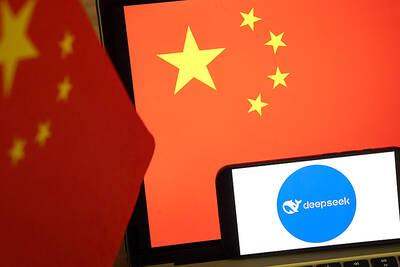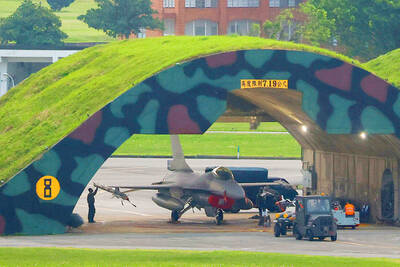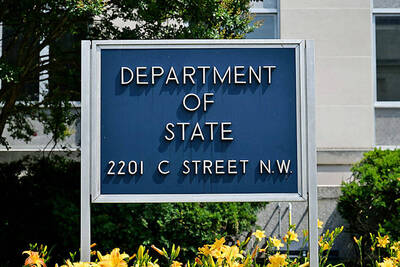With a direct eye on Taiwan, the Chinese military may be moving into the large-scale deployment of unmanned aerial vehicles (UAVs) or drones.
The Associated Press reported over the last few days that Chinese aerospace firms had developed dozens of drones, that its technology was maturing rapidly and that they were “on the cusp” of widespread use for surveillance and combat strikes.
“Taiwan should be concerned about China’s development of large numbers of sophisticated military UAVs,” Ian Easton, a research fellow at The Project 2049 Institute, told the Taipei Times.
Easton, co-author of a recent report on Chinese drones, said there were signs that the Taipei government was taking the situation seriously and “preparing accordingly.”
Intelligence from Taipei on the Chinese UAV fleet indicated that the Military Intelligence Bureau “may have conducted successful operations against China that specifically focused on collecting information about UAVs,” Easton said.
He said that China hides its military aircraft in extensive networks of camouflaged hangers and underground bunkers at virtually every air base across the Taiwan Strait.
Considering that, the bureau could not have gotten its information from satellite imagery and would have had to have used some other measure — “agents on the ground or perhaps cyber espionage,” he said.
Easton said that Chinese UAVs would be deployed in any naval blockade or missile campaign scenario directed against Taiwan.
“They would also support any invasion of Kinmen, Matsu or Dongyin [Isle (東引島)],” he said.
“Given the close proximity of these Taiwanese islands to China, they are probably under Chinese UAV surveillance already, just as the Senkakus [Diaoyutai Islands (釣魚台)] and the Spratly Islands [Nansha Islands, 南沙群島] reportedly are,” Easton said.
The People’s Liberation Army (PLA) Air Force Base near Shuimen Village in China’s Fujian Province, has UAVs stationed there — very close to several of Taiwan’s off-shore islands.
Easton said Taiwan’s main defensive advantages against Chinese UAVs were geography and technology.
“Taiwan has built a remarkable homeland air and missile defense network using its mountainous terrain to protect key facilities and station long-range radars at high elevations,” he said.
“Taiwan’s close relationships with the US military and intelligence community — and Taiwan’s own world-class technology sectors — provide it with some truly cutting edge capabilities for targeting and intercepting attack aircraft, missiles and UAVs,” Easton said.
The key disadvantage for Taiwan was the sheer scope of the Chinese buildup, he said.
“Fortunately, there are very few scenarios in which Taiwan would have to fight alone,” Easton said.
He said he was confident that the US would be there to help and that Japan and others would also support Taiwan.
“Looking ahead, I personally hope that the US and Japan cooperate closely with Taiwan on UAV defense — we have much to learn,” Easton said.
A report published last week by the Carnegie Endowment for International Peace on the future of China’s military and the US-Japan alliance said that recently the tempo of China’s force modernization program had “increased significantly.”
At the same time, China’s Military and the U.S.-Japan Alliance in 2030: A Strategic Net Assessment said that the focus of the modernization had sharpened “largely in response to continued high levels of national economic growth and as a result of specific concerns over increasing US power projection.”
It said there were “growing tensions” with the US and “other regional powers” over Taiwan and maritime territorial issues in the East and South China Seas.
For years Taiwan provided the force-structuring and force-sizing scenario for the PLA, but recently China’s modernization effort had begun to place a greater emphasis on acquiring more ambitious power projection capabilities beyond Taiwan, the report said.
“This military modernization process has created substantial security concerns in the US, Japan and many other countries in Asia, the report said.
Washington’s concern was that the Chinese were developing forces whose primary purpose would be to deny the US military access to the region while the Chinese themselves were projecting power directly onto a “nearby objective,” according to the report.
Such an “anti-access” or “counter-intervention” operation might begin with cyber or physical operations against command-and-control centers and would almost certainly involve UAVs.
“The intent of these actions would be to interfere with American and Japanese intelligence gathering, lengthen the decisionmaking process in Washington and Tokyo and ultimately slow the US military response to events unfolding in the Western Pacific such as a crisis over Taiwan,” the report said.

MISINFORMATION: The generated content tends to adopt China’s official stance, such as ‘Taiwan is currently governed by the Chinese central government,’ the NSB said Five China-developed artificial intelligence (AI) language models exhibit cybersecurity risks and content biases, an inspection conducted by the National Security Bureau (NSB) showed. The five AI tools are: DeepSeek, Doubao (豆包), Yiyan (文心一言), Tongyi (通義千問) and Yuanbao (騰訊元寶), the bureau said, advising people to remain vigilant to protect personal data privacy and corporate business secrets. The NSB said it, in accordance with the National Intelligence Services Act (國家情報工作法), has reviewed international cybersecurity reports and intelligence, and coordinated with the Ministry of Justice Investigation Bureau and the National Police Agency’s Criminal Investigation Bureau to conduct an inspection of China-made AI language

BOOST IN CONFIDENCE: The sale sends a clear message of support for Taiwan and dispels rumors that US President Donald Trump ‘sold out’ the nation, an expert said The US government on Thursday announced a possible sale to Taiwan of fighter jet parts, which was estimated to cost about US$330 million, in a move that an expert said “sends a clear message of support for Taiwan” amid fears that Washington might be wavering in its attitude toward Taipei. It was the first announcement of an arms sale to Taiwan since US President Donald Trump returned to the White House earlier this year. The proposed package includes non-standard components, spare and repair parts, consumables and accessories, as well repair and return support for the F-16, C-130 and Indigenous Defense Fighter aircraft,

CHECKING BOUNDARIES: China wants to disrupt solidarity among democracies and test their red lines, but it is instead pushing nations to become more united, an expert said The US Department of State on Friday expressed deep concern over a Chinese public security agency’s investigation into Legislator Puma Shen (沈伯洋) for “secession.” “China’s actions threaten free speech and erode norms that have underpinned the cross-strait ‘status quo’ for decades,” a US Department of State spokesperson said. The Chongqing Municipal Public Security Bureau late last month listed Shen as “wanted” and launched an investigation into alleged “secession-related” criminal activities, including his founding of the Kuma Academy, a civil defense organization that prepares people for an invasion by China. The spokesperson said that the US was “deeply concerned” about the bureau investigating Shen

DISPUTE: A Chinese official prompted a formal protest from Tokyo by saying that ‘the dirty head that sticks itself out must be cut off,’ after Takaichi’s Taiwan remarks Four armed China Coast Guard vessels yesterday morning sailed through disputed waters controlled by Japan, amid a diplomatic spat following Japanese Prime Minister Sanae Takaichi’s comments on Taiwan. The four ships sailed around the Senkaku Islands — known as the Diaoyutai Islands (釣魚台) to Taiwan, and which Taiwan and China also claim — on Saturday before entering Japanese waters yesterday and left, the Japan Coast Guard said. The China Coast Guard said in a statement that it carried out a “rights enforcement patrol” through the waters and that it was a lawful operation. As of the end of last month,